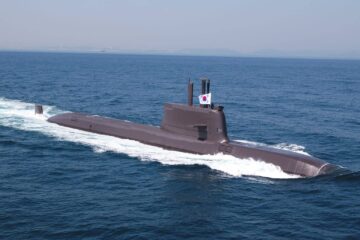DSME announced earlier this month that it won a 1.11 trillion won order from Korea’s Defense Acquisition Program Administration (DAPA) for the detailed design and construction the KSS III Batch II submarine.
For the record, DSME received a contract from the South Korean Ministry of Defense worth $ 1.56 billion to build two large conventional/diesel electric (SSK) KSS III Batch 1 submarines on December 26, 2012. Then, on November 30, 2016, Hyundai Heavy Industries (HHI) received a contract to build another boat of the first batch. All three boats are scheduled to be delivered by the end of 2023. In total, the plan is to introduce into the RoK Navy fleet nine KSS III submarines by 2029: Three boats of each batches (1, 2 and 3)
- The Batch-I consists in the first two hulls to be built by DSME and the third submarine to be built by HHI.
- The Batch-II will consist in three hulls with some design changes. They will be fitted with a greater level of South Korean technology. In May 2016, DAPA selected DSME for “KSS-III Batch-II basic Design”.
- The Batch-III will consists in the three remaining hulls with even more advanced technologies

Compared to the first batch, KSS III Batch II submarine are expected to have a longer hull (of about 5 meters, bringing displacement approx. from 3000t to 4000t), 10x VLS tubes (up from 6x), a greater level of South Korean systems and Lithium Ion batteries and High-Temperature Superconductor (HTS) motor technology for integrated full electric propulsion system.

Talking to Naval News a DSME representative working on the Batch II program explained that another difference will be the addition of a retractable bow thruster. Another difference is that the batch II submarine may revert back to a (penetrating) periscope while the KSS III Batch I has non penetrating optronic masts by Safran (for both the surveillance and attack masts. These were recently selected for Australia’s future Attack-class submarine). According to our information, while KSS II Batch I features both search and attack masts by Safran, the Batch II may be fitted with a search mast (non penetrating) by Safran and an attack persicope (penetrating) by Hensoldt.

As for the Batch I, Hanwha will provide the combat system and LIG Nex1 will provide the entire sonar suite for KSS III Batch II (except for the mine avoidance sonar supplied by Thales): An LIG Nex1 representative told Naval News that the company is supplying:
- Cylinder hydrophone array
- Flank array sonar
- Towed array
- Intercept detection range array
- Active sonar

Regarding the new Li-Ion battery technology by Hanwha Defense, the company is using commercial cells by Samsung SDI. There are 24 cells per tray and 8 tray per modules. There are about 100 modules place forward and another 100 (approximately) aft. The exact number is classified. The new battery technology will improve the energy efficiency with better energy density, battery life and underwater navigation compared to the preceding lead-acid battery technology. Hanwha Defense told Naval News their Li-Ion batteries provide 160% more endurance (longer output) at economic speed and 300% more endurance at maximum speed. Li-Ion batteries also provide double the amount of charge cycles (up to 4,000 or about 10 years of operational life) compared to lead-acid batteries.



The company started tests at a land-based facility back in 2016. So far, only Japan has fitted Li-Ion batteries aboard a submarine for testing. It looks like South Korea will be next with the KSS III Batch II.

First of class ‘Dosan Ahn Chang-ho’ started its seat trials from DSME’s Opko shipyard on June 10, 2019. The SSK successfully reached its maximum depth, as part of its sea trials, on August 22 2019.

The basic design for a rather large ( 3358 tons surface standard displacement, up to 3800 submerged, for the KSS III batch 1) SSK type submarine started in 2004 jointly by Hyundai Heavy Industries and DSME corporations. Local companies LIG Nex1, Hanwha and STX Engine are also involved in the project, as well as British companies BMT and Babcock who provide technical assistance.
KSS-III Batch 1 submarines are fitted with eight 533-mm torpedo tubes for the new Tigershark wire-guided torpedo as well as 6x VLS (vertical launch system) tubes. They would accommodate a future cruise missile (the Cheon Ryong with a range of 1,500 Km) in development by LIG Nex1 while the launchers would be provided by Doosan. It was announced earlier in the program that Spanish company INDRA was selected to provide its electronic defense system (ESM) PEGASO and Babcock of the UK would design and manufacture the Weapon Handling System for the Batch-I submarines.
Construction on first of class SS 083 ‘Dosan An Chang-Ho’ started with the first steel cutting ceremony held at the DSME shipyard in Okpo on November 27, 2014. The naming ceremony took place there on May 17, 2016. The boat was named in honor of one of the leaders of the Korean nationalist movement of the early twentieth century. The launch took place on September 14, 2018.
The keel laying of the second vessel SS 085 ‘Son Byong-hi’ took place at DSME shipyard on July 1, 2016. Hyundai Heavy Industries in Ulsan started construction of the third boat and final vessel of the first batch, SS 086 ‘Yi Dongnyeong’, on June 30, 2017.







One Comment
Pingback : South Korea's HHI and DSME Shipyards Not Impacted by Coronavirus - Naval News